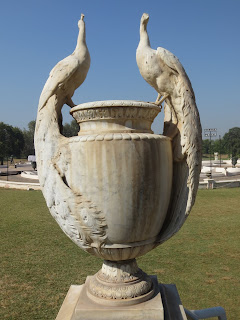In 2016, I spent four days in Gujarat. I was in Ahmedabad for three of those days, and on one day, I did a morning-evening car trip to Baroda. I went to Baroda largely to see Laxmi Vilas Palace, one of India's most magnificent palaces, which I had seen many times in photographs. The proximity to Ahmedabad made the trip a very comfortable one, and the very good quality highway helped.
Baroda, now called Vadodara but still widely known by its old name, lies around 110 km away from Ahmedabad. The city has a population of over 1.6 million, and is the third largest city in the state of Gujarat, after Ahmedabad and Surat. Baroda was a wealthy princely state, ruled by the Gaekwad rulers from 1721 (when the Marathi General, Pilaji Gaekwad, defeated the Mughals) till 1949 (when the princely state acceded to the Republic of India). Maharaja Sayajirao Gaekwad III, who ruled from 1875 to 1939, was the best known ruler in the Dynasty. He was responsible for a lot of development in the princely state.
Laxmi Vilas Palace was built by Maharaja Sayajirao Gaekwad III in 1890 and is one of India's grandest palaces. The Maharaja's descendants continue to reside in a section of the palace, whereas large parts of the palace are open to visitors. The complex also has the Maharaja Fateh Singh Museum. Laxmi Vilas Palace was the world's largest dwelling unit when it was built. In the 1930s, a golf course was opened in the complex for the Maharaja's European guests.
 |
| Laxmi Vilas Palace |
 |
| Peacock Urn, Laxmi Vilas Palace |
 |
| Moses Statue, Laxmi Vilas Palace |
 |
| Stag Statue, Laxmi Vilas Palace |
Sayyaji Gaekwad III was born in 1863 and died in 1939. He became Maharaja of Baroda in 1875 and continued until his death. In 1870, the Maharaja of Baroda, Khanderao Gaekwad died. His brother, Malharrao became the next Maharaja. He was, however, deposed in 1875 on account of his tyranny and the fact that he had nearly emptied the state's coffers. Maharani Jamnabai, the widow of Khanderao Gaekwad, called extended branches of the family, so that the next king could be chosen. Gopalrao, then just 12, was chosen. When he was asked why he had come, he confidently said "I have come here to rule". He was crowned later that year and given the name Sayajirao Gaekwad III. He was only a minor then, and got full ruling powers only in 1881.
Sayyaji Gaekwad III had many achievements during his decades as the Maharaja. His achievements included education of the masses, upliftment of the poor, a ban on child marriages, removal of untouchability, encouragement of the arts, establishment of a railroad and establishment of the Bank of Baroda. Upon his death, his grandson, Pratapsinhrao Gaekwad, became the next Maharaja, and ruled from 1939 to 1951. During his rule, Baroda acceded to the Union of India in 1949. Fatehsinghrao Gaekwad II ruled from 1951 to 1988. During his rule, in 1971, royal titles in India were abolished. Unofficially, Ranjitsinh Pratapsinh Gaekwad was Maharaja from 1988 to 2012. Samarjitsinh Gaekwad then took over in 2012.
 |
| Overview, Laxmi Vilas Palace |
 |
| Bull Statue, Laxmi Vilas Palace |
 |
| Mural, Laxmi Vilas Palace |
 |
| Exit Doorway, Laxmi Vilas Palace |
Baroda Museum and Picture Gallery was built in 1894 in the Indo-Saracenic architectural style.. The museum has a fine collection of European paintings, sculptures, Mughal costumes, Mughal miniature paintings, weapons, an Egyptian mummy, Tibetan arts and a blue whale skeleton.
 |
| Baroda Museum and Picture Gallery |
 |
| Interior, Baroda Museum and Picture Gallery |
 |
| Busts of rulers of Baroda, Baroda Museum and Picture Gallery |
 |
| Helmet, Baroda Museum and Picture Gallery |
 |
Mughal Costume,
Baroda Museum and Picture Gallery |
Baroda Museum and Picture Gallery lies inside
Sayaji Baug, a large park that was opened by Maharaja Sayajirao Gaekwad III in 1879. The park is spread over an area of 113 acres. The park also has a toy train (which takes visitors on a 20 minute ride), a zoo (which prides itself on its collection of Asiatic lions), an aquarium, a large floral clock (with a 6.1 meter diameter) and a planetarium (which can take up to 200 spectators).
 |
| Palm Trees, Sayaji Baug |
 |
| Sculpture of a Hunting Boy, Sayaji Baug |
It was a pleasant day in Baroda. Laxmi Vilas Palace certainly lived up to the grandeur I had read about. The attractions in Sayaji Baug were also very interesting. All in all, I enjoyed my visit and had fun learning about the fascinating history of this former princely state.















No comments:
Post a Comment